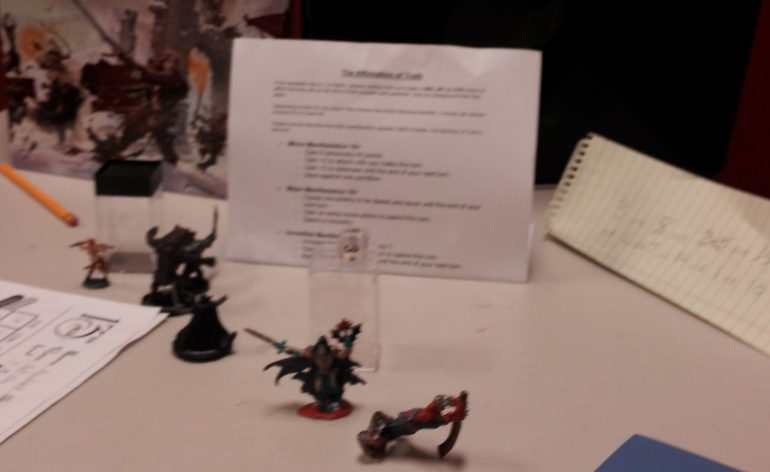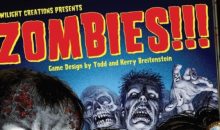13th Age Monsters – The Evil Party
13th Age Monsters – The Evil Party!
Last week I talked about an encounter that Jon and I worked on together in 13th Age – the Manifestations of Will. When Jon and I ran this encounter in our respective games, we each used the mechanic with an evil version of our party. He used the manifestation mechanic as Roll to Disbelieve, letting the PCs in his game refuse these evil versions of themselves. When I ran it, I used the mechanic as Affirmations of Faith, affirming the PCs’ faith in their willpower to not follow these evil paths. Both fights were big hits, and letting the party kill themselves and each other (well, okay, their EVIL selves) was a huge key to that success.
This fight should be cinematic and epic, relying heavily on the players to narrate the way their manifestations effect themselves, their environment and the enemies. Part of how we got players really involved was making these monsters not just based off the players’ classes, but the players’ characters. There are tons of evil rogues, wizards or sorcerers, but only one is the evil version of the rogue, wizard or sorcerer in your party. The key to making the evil version of your party is to make sure they are recognizable AS your party.
To do this, I made sure to design monsters based around the parts of the players’ classes that they enjoy and use often – the abilities and spells that became iconic to those characters. Our ranger is a character built more around utility than damage, so her evil demonic version summoned a devilish bear when she was staggered. Our wizard was already a necromancer, so his evil version took it up to 11 to become a rotting lich. The wizard was also a great class to play with – there’s a ton of spells to pick from to throw at the party, but I didn’t want this to be any lich-wizard, I wanted this to be an evil version of OUR wizard. At lower levels this wizard’s favorite spell was always Acid Arrow, and rightfully so, as he used it to cut huge swathes of destruction through fights from level 1 to 3, probably dealing more damage with it than the rest of the party put together. It was pretty easy to pick Acid Arrow as the spell for my evil wizard, then I just tuned it up to be something that boss would use by gaining inspiration from the wizard’s racial (the drow’s Cruel). In the end I had ‘Cruel Acid Barrage,’ a spell fit for an evil necromantic wizard and a spell all of my players were immediately afraid of.
I really recommend you design your own monsters for a truly memorable encounter. I’ve included some of the monsters Jon and I used as evil versions of our groups as examples.
Savage Fighter, 4th level wrecker
Ini + 5 | HP 63 | AC 20 | PD 18 | MD 15
◆ Huge Sword + 8 vs AC: 18 damage
Miss: 9 damage
Savage Intercept: Once per round the Savage Fighter may roll a normal save (11+) to intercept an enemy who is moving to attack a nearby ally. He can pop free from enemies to move and intercept the attack. The moving enemy makes its attack with the Savage Fighter as a target instead and upon miss, the Savage Fighter may deal 1d8 damage or heal 1d8 of his own HP.
Brutal Retaliation: Every time the Savage Fighter is damaged by an attack its crit range cumulatively increases by 1. Once a crit is made, this bonus starts over at 0.
GM Sidebar: We like to use blood red tokens to signify the bonus to the players.
Necromantic Wizard, 4th level spoiler
Ini + 5 | HP 55 | AC 18 | PD15 | MD 18
◆ R: Cruel Acid Barrage + 9 vs PD: 14 damage, 7 ongoing damage
Natural even hit: ongoing weakened (save ends both)
◆ Necrotic Spray + 7 vs MD (all nearby enemies): 10 damage and all engaged enemies are pushed out of engagement.
Natural odd hit: 5 ongoing damage
Skeletal Guardians: As a move action, the Necromantic Wizard may summon one Skeletal Guardian. When successfully attacked, the Necromantic Wizard may roll 1d20 (success 6+) for the Skeletal Guardian to become the target of the attack, destroying the Guardian but leaving the Necromantic Wizard unaffected.
Hellranger, 4th level archer
Ini + 7 | HP 58 | AC 19 | PD 18 | MD 15
◆ R: Devil Longbow +10 vs AC (2 attacks): 7 damage
Lethal Portents: Every time the Hellranger makes an attack roll note the roll’s natural value on a list where everyone can see it. If a PC makes an attack roll that matches any of the values on the list a searing hex appears on the PC’s body. Deal 10 fire damage to the PC for every match on the list. Remove the matching number or numbers off of the list after dealing the damage.
GM Sidebar: It’s up to you whether or not this damage can kill an attacker before they get to attack. Jon’s advice is to have the damage trigger after the attack is resolved so there’s no possibility of stopping the attack before hand. But you might want to be more cutthroat about it – I am, because this is an ability designed to be a dangerous surprise when it goes off, not a bread and butter part of the monster.
Devilbear: When the Hellranger is staggered, she summons a 1st level demonic bear that acts after her in the initiative order.
Devilbear
1st level bear
AC 18 | HP 36 | PD 16 | MD 12
◆ Corrupt Claws + 7 vs AC: 7 damage
Miss: The next Corrupt Claws attack to hit will deal 10 damage.
Bloody Rogue, 5th level wrecker
Init +10 | HP 60 | AC 21 | PD 18 | MD 16
◆ Shadow Strike +8 vs AC (2 attacks): 7 damage; Sneak attack: 2d6 extra damage
Special: When the escalation die is odd the Bloody Rogue can teleport to a nearby target before the attack and then teleport away to a nearby location after.
◆ Shadow Darts +8 vs AC (2 attacks): 7 damage
Bloody Momentum: The first time the Bloody Rogue successfully hits a target with an attack during its turn it chooses to gain one of the two following benefits:
Stabbing Surprise: Until the beginning of the Bloody Rogue’s next turn any time it is targeted with a melee attack it can deal 2d6 damage to the attacker as a free action. This damage is dealt before the attack is attempted.
Slippery Bastard: Until the beginning of the Bloody Rogue’s next turn any time it is targeted by a non-melee attack it only takes half damage.
Apocalyptic Bard, 5th level leader
Init +8 | HP 72 | AC 20 | PD 17 | MD 17
◆ Red in Tooth and Claw +10 vs AC: 18 damage
◆ Song of Omens +10 vs MD (ranged): 14 psychic damage plus an extra 1d8 damage per condition that a save can end on the target
Song of Extinction: All enemies take -3 penalty to saves and all allies gain a +3 bonus to saves.
Reverberation: Any time the bard rolls a natural even attack roll a nearby ally can gain 10 temporary hit points as a free action.
Crazed Sorcerer, 5th level caster
Init +6 | HP 72 | AC 19 | PD 17 | MD 20
◆ Breath of Miasma +8 vs PD (1d4 nearby enemies, once per encounter): 10 ongoing unholy damage (save ends)
◆ Scorching Ray +10 vs PD (one nearby enemy): 16 fire damage.
Natural even hit: 2d6 ongoing fire
◆ Forked Lightning +10 vs PD (one nearby enemy, once per encounter): 18 lightning damage
Natural even roll: repeat the attack against a new target.
Gather Power: As a standard action, the Crazed Sorcerer gathers power this turn and gains a chaotic benefit from the chart below. The next turn after using Gather Power, the Sorcerer’s spells deal double the normal damage.
Roll 1d6:
1-2: Gain +1 bonus to AC and PD for 1 round
3-4: Deal 7 unholy damage to all nearby staggered enemies
5-6: Deal 7 unholy damage to one nearby target






